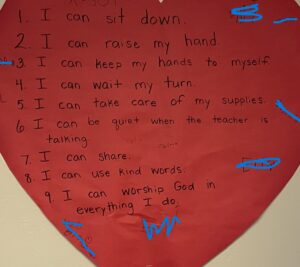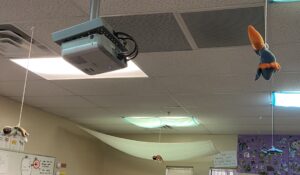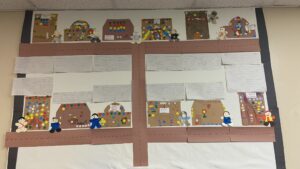My name is Hannah Forrider, and I teach Kindergarten at Desert Christian Schools.
Younger elementary is all about learning how to be in a community, interact with other people, regulate emotions, have self-control, and more. There is truly so much joy to be had in a Kindergarten classroom, yet when teachers and students don’t know each other, the classroom environment is unbalanced, leaving the children feeling insecure and unsafe and affecting their ability to learn; community building in a classroom is so important. I’ve broken down my top classroom community building activities into three categories according to the ways that I integrate them.
Academic
Classroom Rules
At the very beginning of the school year, I have the children come up with their own classroom rules. This requires a bit of guidance, but by doing this, everyone feels part of the community right away.

Table Mascots
Another great beginning of the year activity is each table group picking their own table animal mascot. This teaches students how to interact, share, and consider their classmates at the beginning of the year. Sometimes it takes 20 or more minutes of guidance to get them to be selfless and let someone else’s animal get picked over theirs.

Community Helpers
In December, during our community helpers unit, we create a gingerbread community on the bulletin board where each student picks a community helper, creates it, and their building. This is the perfect opportunity to talk about the class community and our roles in it, as well as contribute toward creating it, just like the communities we live in outside the school walls.

Team Drawings
When I have lessons that are more open-ended and I’m just interested in what they’ve learned overall, I’ll ask the kids to draw/create a mural of what they’ve learned or the answer to a question I pose in pairs or table groups. This gives them another opportunity to share ideas with each other, as well as a space to figure out how to integrate each of their thoughts on the paper. This closure activity helps the kids build physical awareness and leadership skills as well as empathy for their peers’ thoughts and ideas.
Biblical
Find the Missing Student
One student is picked to go in a separate area from the other students. While that student is hiding or closing their eyes, you pick another student to step outside of the classroom who is the “missing” student. The first student comes back into the classroom or opens their eyes and has to figure out who the “missing” student is. This game allows the kids to truly learn who their classmates are as well as think about someone other than themselves and their close friends. My biblical integration ties into the Parable of the Lost Sheep to show how Jesus treats His people\His flock. He leaves the 99 to go find the missing one, and He knows all of His sheep by name.
Sharing Blessings
I also encourage community building by having the students share ways someone has blessed them that day, or things they are thankful for. The kids often share about one of the ways a peer was kind or nice to them.
Not only does this boost the students’ self-confidence, which can even help with behavior issues, but it also increases peer-to-peer camaraderie because they realize that someone else is noticing how they shine Jesus’ light to others. Christian school teachers have such an important job to disciple our children in the ways of the Lord.
We must model for our kids and teach them how to honor God in all that we do and say. Encouraging others, building up one another, and serving others are easy things that we can show our children how to do, as well as praise when we see it in our kids. These things are essential fruit in the life of a believer, and we should be sure to positively reinforce godly actions we see.
Social
Would You Rather?
This game helps boost classroom community while allowing teacher and students to get to know & connect with each other.
Scavenger Hunts
Partner or group scavenger hunts can build teamwork and leadership skills while doing something they love.
Scavenger Hunt Ideas:
-Look for 10 items that are blue
-Collect 3 squares, 2 circles, and 1 rectangle
-Collect 4 items that make the long a sound
Lego Challenge
Split the kids into pairs or teams and time them on how fast or how well they can build something. Incorporate it into a lesson, make it a type of formative assessment or closure, and let the kids have fun in the learning.
I have found that there are truly many easy moments throughout the day that lend themselves to great team building amongst the students. Be willing to be led by the Holy Spirit, and He will be faithful to guide you in the numerous ways your students need to be discipled and shaped in ways you could never have thought of on your own.
